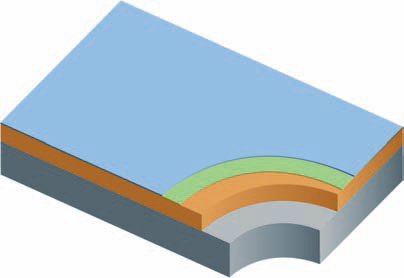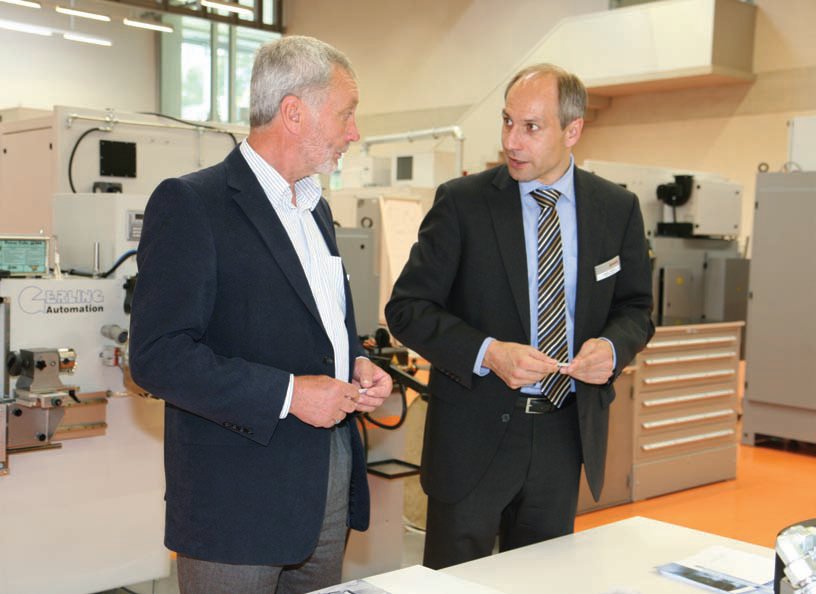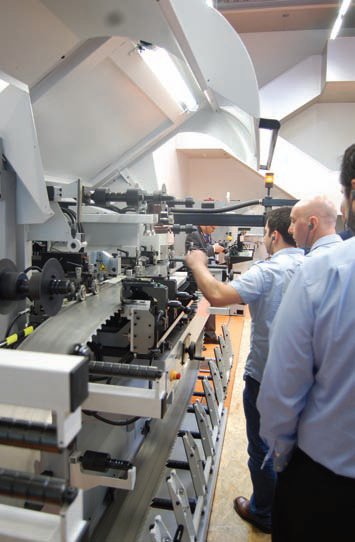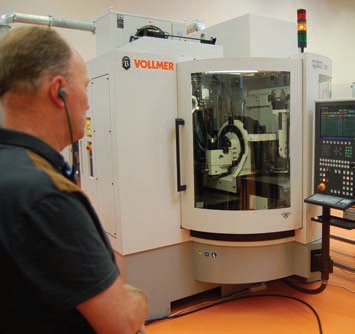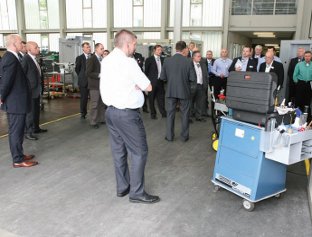Diamond league
1 September 2012TTJ news editor Stephen Powney joined Vollmer UK customers for the company’s PCD Days at its headquarters in Biberach
About 30 UK tooling specialists made the trip to Upper Swabia in Germany for Vollmer's first PCD Days event. The companies, including leading UK PCD (polycrystalline diamond) tooling and TCT (tungsten carbide tipped) blade manufacturers,were given an insight into the latest on PCD tooling, plus a detailed tour of the vast operation run by tool sharpening/grinding machinery producer Vollmer at its Biberach headquarters.
Vollmer is a picture of how a Swabian business has transformed itself into a global player and is part of a dynamic industrial hub in Biberach which also includes leading crane company Liebherr, pharmaceutical giant Boehringer Ingelheim, as well as bases for leading dental, aerospace and electrical utilities companies.
Vollmer was established in 1909 and is still family-owned today, with 86-year-old Sieglinde Vollmer, who owns about 50% of the company, meeting the UK delegation during the trip.
Five hundred staff work at Vollmer's HQ, with a total of 650 employees worldwide. A manufacturing plant already operates in China to serve the local market there, while an Indian office is being set up.
Three production halls and a futuristic technology training centre at Biberach form a significant operation for the company, whose turnover is just under €100m.
The PCD Days event featured presentations from partner companies in the fields of measuring, cutting and brazing technologies - all key activities in the production and sharpening of tools for the woodworking industries.
Element Six, a world-leading supplier synthetic industrial diamonds for tooling, outlined the cutting performance of the latest PCD tooling.
The company, which manufactures tool blanks, bills itself as providing "extreme performance". It has 3,000 employees in 16 countries, and is owned by De Beers and Umicore.
Dr Peter Harden, Element Six market support centre manager, reminded the UK delegation that diamond was the hardest substance known to man and by combining it with other materials it was possible to produce "supermaterials" for cutting and drilling.
Element Six's latest supermaterial for the woodworking trade is the WPC102, a composite, multi-layer product featuring a tungsten carbide substrate, topped by a PCD layer comprising two types of diamond powder combined with cobalt and then a thin metal top coating.
Improvement in tool life
The material was introduced for machining highly abrasive wood and panel products and can, Element Six claims, offer up to nearly three times the improvement in tool life compared with standard PCD tooling.
Dr Harden said the lifespan of PCD tools was typically 10-150 times that of carbide. Testing had shown WPC102 provided a dramatic improvement in impact resistance,with a sawblade tested as giving 160 times the tool life of WC (tungsten carbide tooling), he said.
The WPC102 tool achieved 900,000 linear metres of tool life, with resharpening after about every 125,000 linear metres. Generic PCD has a tool life of about 385,000 linear metres, with resharpening every 50,000 linear metres.
WPC102 achieves its increased resistance to chipping through controlled break-in of the cutting edge in the early stages of tip wear, giving a more stable cutting edge which can cut for longer.
Dr Harden said the product provided a "new paradigm in woodworking". It was more expensive but it reduced tool manufacturing costs by 25% and resharpening costs by 30%, while increasing the toolmaker's margin by 50%.
For the end user, Element Six says the cost per linear cut metre is reduced by 50% for a 10% increase in purchasing of the tool, meaning less downtime and a reduced carbon footprint.
He said performance in laminated chipboard, chipboard and hardwood was excellent, while "very good" with softwood and MDF.
Element Six is investing significantly in the UK by centralising its R&D. This involves the building of a £20m facility near Oxford. Due to open in the first quarter of 2013, it will be its global R&D hub - "the largest and most sophisticated synthetic diamond supermaterials R&D centre in the world", according to Dr Harden.
It's not just the raw materials of tooling that are transforming the industry's processing abilities. Further equipment in the field of tool presetting, inspection and measurement is also pushing the boundaries.
Zoller, which makes this equipment for PCD tools and sawblade applications, showed Vollmer customers how its camera-based technology was boosting accuracy and efficiency in tool machining and servicing.
Its Genius five-axis CNC range uses two cameras, with up to 200-500 magnification, and provides photorealistic input dialogue giving radial and axial visual measurement, rather than lots of text, providing fully automatic measurement of all tool characteristics.
Zoller has 28,000 devices and software solutions installed on the market, with about 350 in the UK, including about five high-end machines.
Vollmer customers also heard about future opportunities and challenges in the cutting industries from keynote speaker Dr Neil Calder who sits on the UK Technology Strategy Board.
Alternative technologies
One challenge to conventional cutting is the increase of water-jet and laser cutting.
Water cutting has the advantages of sanding the surface while cutting it, while the width of the water jet (which contains an abrasive material) gives a narrow kerf so little material is wasted during cutting and complex designs can be produced. Also, water cutting creates no heat to damage the workpiece.
Whether these technologies will have any significant future impact on the wood machining trade remains to be seen.
Vollmer is clearly confident in the future for its products and is investing heavily in R&D. Sales director Jürgen Hauger said 80 staff worked in the R&D department, with 8-10% of Vollmer's €100m global turnover invested back into R&D annually.
Its QXD200 and QXD400 erosion and polishing machine tools have now received extended functionality for processing PCD drills and cutting tools with a high shear angle. The latest QXD is now at least 2.5 times faster than its QM predecessor machine of four years ago.
Vollmer estimates that, with improved motion systems, automation systems and software strategies, QXD erosion is now at least 30% faster than grinding.
Similar performance improvements are also being seen on Vollmer's new fully automatic CM3090 and CMF300 sharpening machines for carbide-tipped circular saw blades.
On the 29,000m2 Biberach site, a large percentage of machine production is completed in-house on a variety of Heller, Index and Chiron CNC machines, while Vollmer has its own software and electrical departments. "We are very flexible about demands from the market because everything is in-house," said Mr Hauger.
Machine assembly takes about two to three weeks, while about 800-1,000 machines are produced very year. Some units built in the 1950s and 1960s are still working.
Like many long-standing German engineering companies, Vollmer was harnessed for the war effort during the second world war, making machine gun parts and propellers.
Post-1945 machines were built using concrete bases because of the shortage of steel. Now they are constructed of polymer concrete.
As well as R&D, training for the next generation of Vollmer workers is a high priority. Incredibly, 14% of the workforce are apprentices - 62 young people.
"It's very hard to get young people [because of the competition with other notable companies in the area], so we're trying by going into the schools to tell them that Vollmer is a good company to work for," said Mr Hauger. "This is good for the future of the company."
